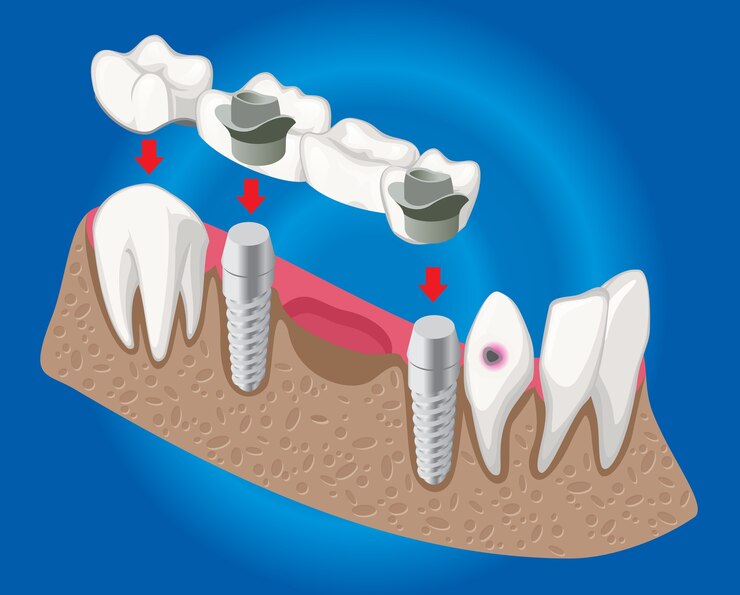Crafting Smiles A Comprehensive Guide to Crowns and Bridges in Dentistry.
In the realm of restorative dentistry, crowns, and bridges stand as time-tested solutions to address a myriad of dental concerns, from damaged or decayed teeth to gaps caused by missing teeth. These prosthetic devices not only restore functionality but also play a crucial role in enhancing the aesthetics of a smile. In this article, we delve into the world of dental crowns and bridges, exploring their purpose, types, the process of placement, and the transformative impact they can have on oral health.
To Know More About It Please Click Here
Understanding Dental Crowns
- Purpose and Functionality:
- Dental crowns, often referred to as caps, are custom-fitted prosthetic coverings designed to encase a damaged or weakened tooth.
- They provide structural support, restore shape and size, and improve the overall strength of a tooth.
- Indications for Dental Crowns:
- Protection for a severely decayed tooth.
- Restoration of a fractured or chipped tooth.
- Support for a tooth following a root canal procedure.
- Enhancement of the appearance of misshapen or discolored teeth.
- Types of Dental Crowns:
- Porcelain Crowns: Known for their natural appearance, these crowns are ideal for front teeth.
- Metal Crowns: Durable and resistant to wear, often used for molars.
- Porcelain-Fused-to-Metal (PFM) Crowns: A combination of porcelain and metal, offering both aesthetics and strength.
The Crown Placement Process:
- Consultation and Evaluation:
- A thorough examination is to assess the condition of the tooth and determine the most suitable type of crown.
- Tooth Preparation:
- The affected tooth is shaped to accommodate the crown, ensuring a proper fit.
- Impression Taking:
- An impression of the prepared tooth is made to create a custom-fitted crown.
- Temporary Crown Placement:
- While the permanent crown is being crafted, a temporary crown is placed to protect the prepared tooth.
- Permanent Crown Installation:
- Once the permanent crown is ready, it is securely bonded to the tooth using dental cement.
Bridging the Gap: Dental Bridges
- Purpose and Functionality:
- Dental bridges are prosthetic devices used to fill gaps created by one or more missing teeth.
- They consist of artificial teeth, called pontics, anchored by dental crowns on adjacent natural teeth.
- Types of Dental Bridges:
- Traditional Bridges: Anchored on both sides by dental crowns.
- Cantilever Bridges: Supported by dental crowns on only one side.
- Maryland Bridges: Bonded to adjacent teeth using metal or porcelain wings, minimizing the need for crowns.
The Dental Bridge Placement Process
- Evaluation and Treatment Planning:
- A comprehensive examination to determine the type of bridge needed and assess the health of adjacent teeth.
- Tooth Preparation:
- The teeth adjacent to the gap are shaped to accommodate dental crowns.
- Impression Taking:
- Impressions are made to create a precise model for the fabrication of the dental bridge.
- Temporary Bridge Placement:
- A temporary bridge is often placed while the permanent bridge is being crafted.
- Permanent Bridge Installation:
- Once ready, the permanent bridge is cemented into place, restoring the appearance and functionality of the smile.
Transforming Smiles, Enhancing Lives
- Aesthetic Benefits:
- Crowns and bridges not only restore function but also contribute to a natural and aesthetically pleasing smile.
- Improved Oral Health:
- By filling gaps and strengthening weakened teeth, these restorations promote overall oral health and prevent further complications.
- Boost in Confidence:
- Restoration of a complete and functional smile often leads to increased confidence and improved self-esteem.
To Know More About It Please Click Here
Conclusion
Dental crowns and bridges are invaluable tools in the realm of restorative dentistry, offering solutions for both functional and aesthetic concerns. Through careful evaluation, precise preparation, and expert craftsmanship, these prosthetic devices contribute not only to the preservation of oral health but also to the enhancement of smiles, ultimately transforming lives one tooth at a time. Regular dental check-ups and consultations with a qualified dentist play a pivotal role in determining the most suitable restorative options for individuals seeking to regain the beauty and functionality of their smiles.






